Leadership in Business Final
1/43
There's no tags or description
Looks like no tags are added yet.
Name | Mastery | Learn | Test | Matching | Spaced |
|---|
No study sessions yet.
44 Terms
assigned leader
people who are leaders due to their formal position or job title
emergent leaders
people who become leaders based on how others perceive them and how others respond to them, regardless of formal job title
managers
Management
Planning and budgeting
Organizing and staffing
Controlling and problem solving
Unidirectional authority
Reactive, dealing with problems as they arise
Lower emotional involvement
Give instructions
leader
People who engage in leadership
Establish direction
Aligning people
Motivating and inspiring
Multidimensional influence
Shape ideas
Emotionally involved
Influence followers, change the way people thinking about what is possible
Leadership
a process whereby an individual influences a group of individuals to achieve a common goal
Great Man Theories
focused on identifying innate qualities and characteristics of great social, political, and military leaders
Trait approach
Focuses exclusively on leader
What are the traits of a leader?
Who has these traits?
5 major leadership traits
Intelligence
Self-confidence
Determination
Integrity
Sociability
Intelligence and Leadership
Curvilinear- relationship between intelligence and perceived leadership is nonlinear
Intelligence perceived with leadership, only up to a certain point. If intelligence is too high, people may not assume you are a leader
Skill approach
Focuses on the leader
Similar to trait
Emphasis on skills and abilities that can be learned and developed
Different from trait
Three Types Skills
Technical skills- having knowledge about and being proficient in a specific type of work activity
Working with things
Human Skill- having knowledge about and being able to work with people
Working with people
Conceptual skills- the ability to do the mental work of shaping meaning of organizational policy or issues (what company stands for and where its going)
Working with ideas
Skill Model of Leadership
What leadership factors lead to high performance in an organization?
Capability Model: examines the relationship between a leader’s capabilities (knowledge and skills) and the leaders performance
Skills can be learned and developed so anyone can be a leader
Markman’s 2017 Harvard Business Review article, “Can you be a great leader without technical expertise”
leadership education needs to evolve
challenges of generalist leadership
implications for training future leaders
should include real world examples and case studies for specific industries
organizational risks
4 main points of:
Can you be a leader without technical expertise? Harvard business review main point
Get a hint
leadership education needs to evolve
challenges of generalist leadership
implications for training future leaders
should include real world examples and case studies for specific industries
organizational risks
Can you be a leader without technical expertise? Harvard business review main point. To lead effectively, you need technical or domain expertise along with general leadership abilities
Behavioral Approach
Emphasizes the behavior of the leader
Focuses exclusively on what leaders do and how
they act
Task Behaviors vs relational
Task Behaviors: focusing on getting the job done.
Relationship behaviors: focusing on relationships with subordinates and subordinates’ wellbeing.
Ohio State studies: two types of leader behaviors
identify number of times leaders engaged in 150 specific behaviors: two highest below
initiating structure: leaders provide structure for subordinates
task behaviors: organizing work, giving structure, defining role responsibility
consideration: leader nurtures subordinates
relationship behaviors: building camaraderie, respect, trust, and liking between leaders and followers
these are independent! you can be high in both, low in both, high in one and medium in another
University of Michigan Studies
examined how leaders behavior affects the performance of small groups: two types of leadership behaviors prevalent
production orientation- technical aspects of the job (employees seen as a means to get a job done)
employee orientation- strong human emphasis (employees seen as human)- similar to Ohio states “consideration”
Originally seen as OPPOSITE ends of a single continuum/spectrum
Now it is seen as independent dimensions
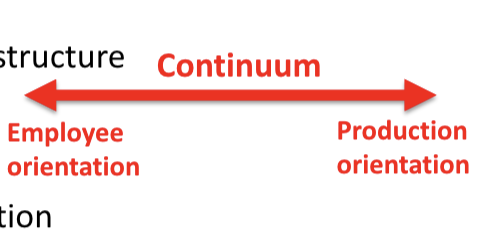
Blake and Moutons Leadership Grid
purpose: designed to explain how leaders help organizations to reach their purposes
two factors
concerns for production- how a leader is concerned with achieving organizational tasks
concern for people- how a leader attends to the members of the organization who are trying to achieve its goals
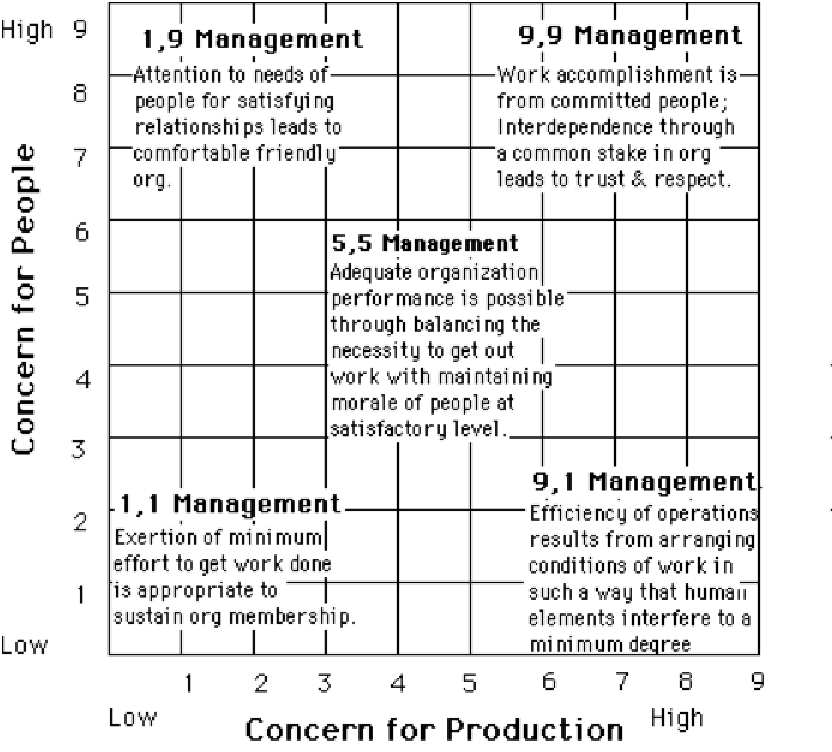
Blake and Moutons Leadership grid titles
Middle of the road (5,5)- medium orientation for task and people
country club (9,1)- high concern for people low concern for task
Team management (9,9)- high people and high task
impoverished management (1,1)- low people low task
Authority compliance- low people high task
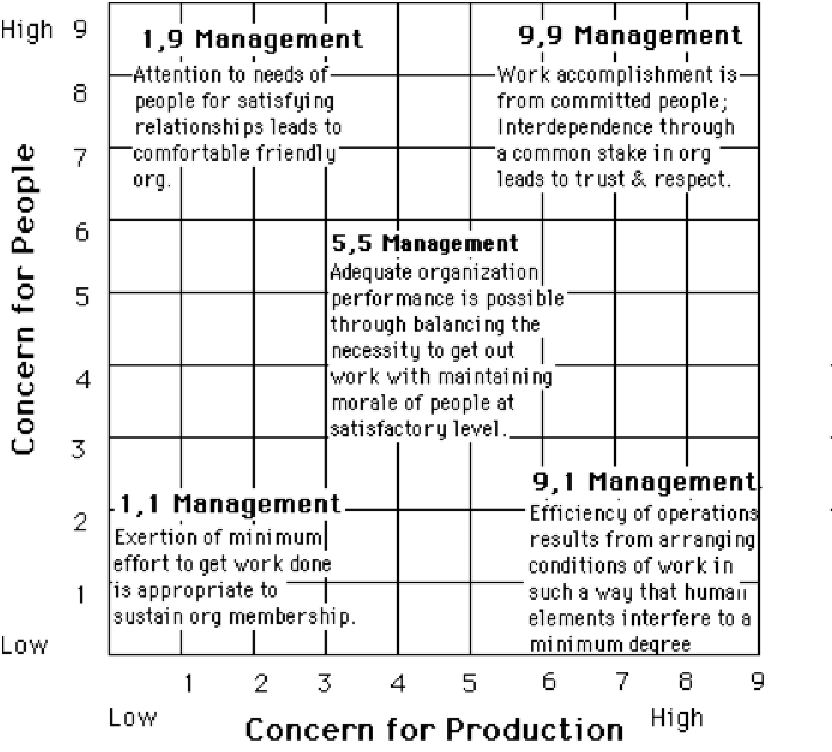
Leader Member Exchange Theory (LMX)
leadership as a process
centered on the interactions between a leader and followers
in group vs out group
in group- group of people who identify with each other based on a variety of factors
can be demographic: race, gender, religion
can be about membership: fav sports team, sorority, table tennis
out group- people who do not belong in the in group
Leadership Making
prescriptive
descriptive
A prescriptive approach to leadership that emphasizes that a leader should develop high-quality exchanges with all of her or his followers, rather than just a few.
Prescriptive: What the leader should do
descriptive: how LMX develops in practice
authentic leadership
focuses on whether leadership is genuine
newer approach to leadership
interest in authentic leadership
people want leaders they can trust b/c the 2000’s was considered an era of anxiety and uncertainty
9/11
covid
corporate scandals
“fake news”
fears of foreign influence in US elections
Three definitions of authentic leadership
Two approaches to authentic leadership
Practical approach- Approach evolved from identifying real-life examples of authentic leaders
understand their purpose
strong values
trusting relationships
self-discipline
act from the heart (mission)
Theoretical approach- Model of authentic leadership- results of research of leadership
still developing because it is very new
hard to define the construct of authentic leadership and identify its characteristics

Followership
a process whereby an individual or individuals accept the influence of others to accomplish a common goal
Perspectives on followership (role and relational based)
Role Based: Examines the typical roles followers enact while occupying a formal or informal position within a hierarchical system.
How does followers’ behavior affect the leader and organizational outcomes?
Relational Based Perspective- Social constructivism: People create meaning about their reality as they interact with each other.
Followership is co-created by the leader and
followerFocuses on the interpersonal process and attempts
to influence and responses to influence attemptsFollowership is associated with interpersonal
behaviors
4 typologies of followership
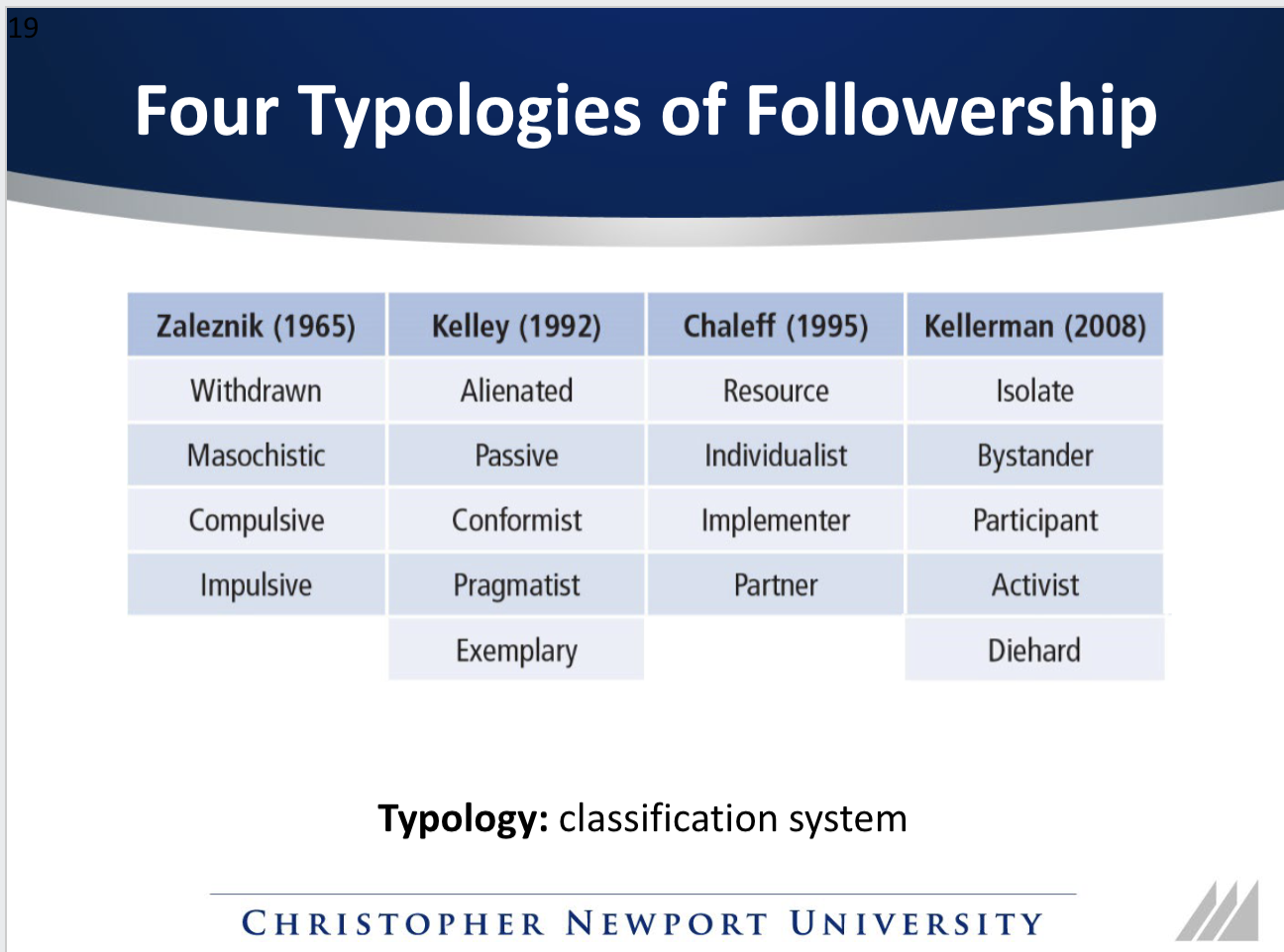
Zaleznik Typology (1965)
two axes of follower behavior:
dominance/submission
passivity/activity

Kelley Typology
Most recognized followership typology
Followers are enormously valuable to organizations
Emphasizes the motivations of followers
Exemplary followership
Characteristics of Exemplary Followers
1. Self-manage and think for themselves; exercise
control, work without supervision.
2. Show strong commitment to organizational
goals and well as personal goals.
3. Build their competence and master job skills.
4. Are credible, ethical, and courageous
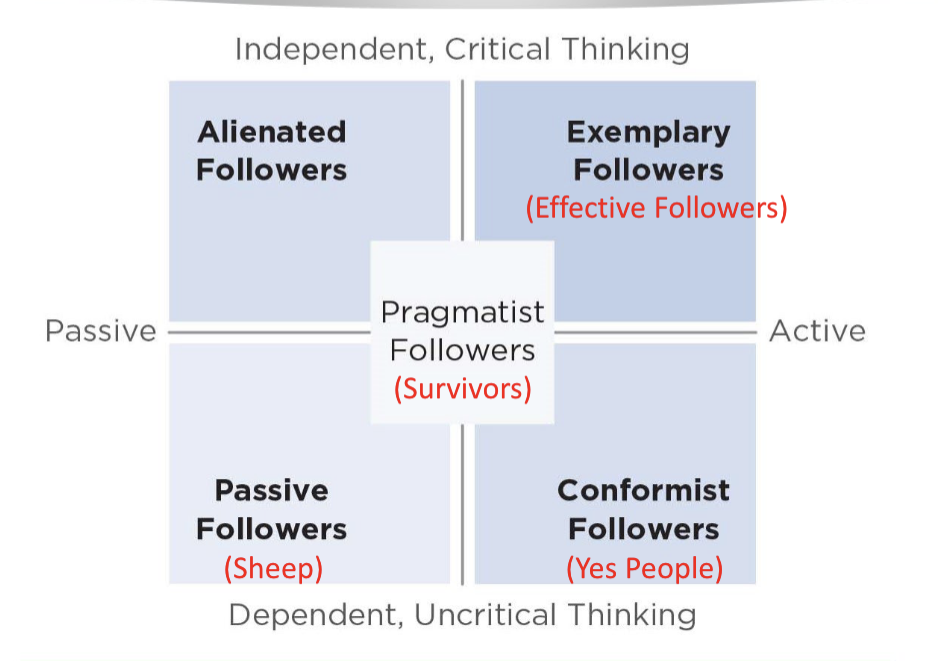
Chaleff Typology (1)
Motivated by World War II.
– Why did people follow Hitler and other
evil leaders?
– What can be done to prevent
something similar from happening
again?
• Followers should be viewed as serving a common purpose along
with leaders, rather than as serving leaders
• Wanted to increase followers’ sense of agency and make followers more responsible and proactive
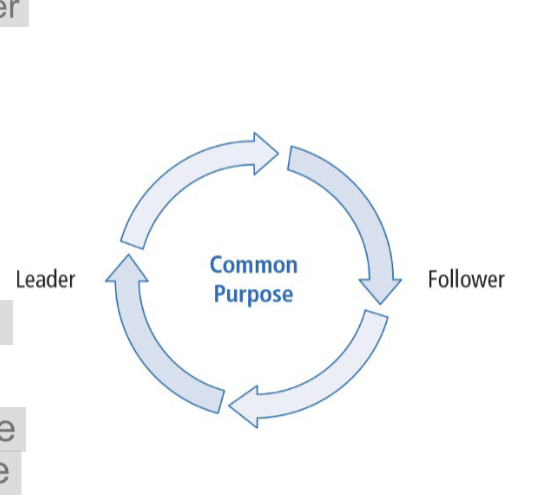
Chaleff Typology (2)
Followers need courage to:
• Assume responsibility for the common purpose
• Support the leader and organization
• Constructively challenge the leader if the common
purpose or integrity of the group is being threatened
• Champion the need for change when necessary
• Take a moral stand that is different from the leader’s to
prevent ethical abuses
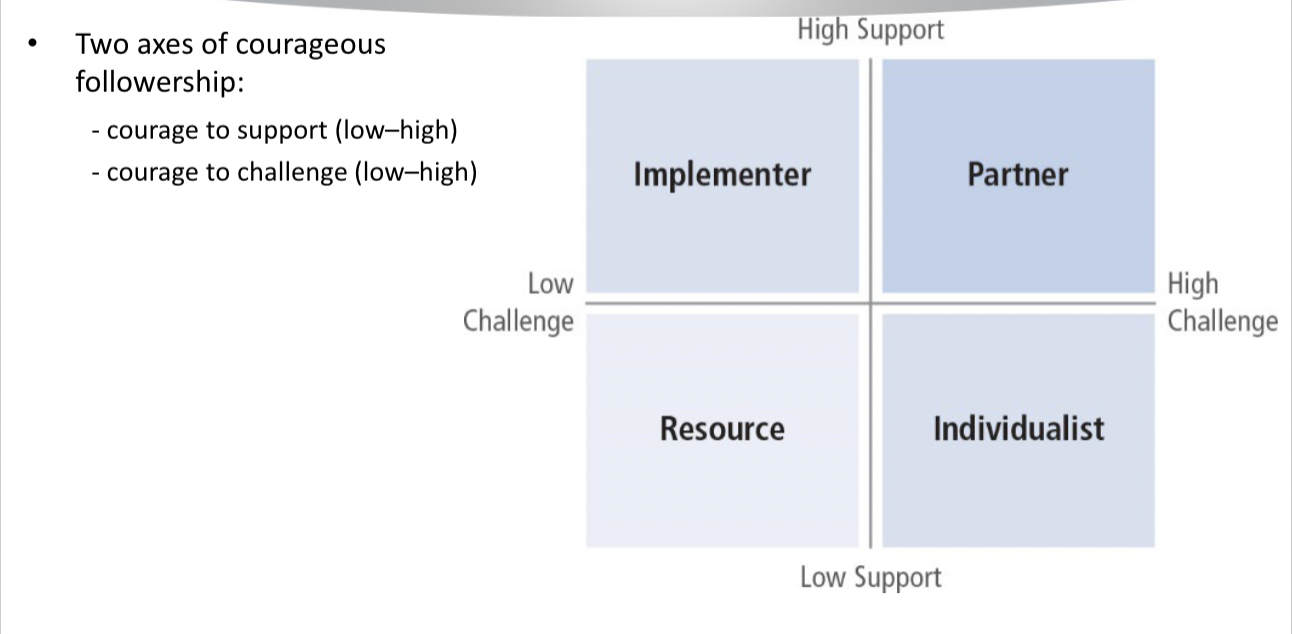
Kellerman Typology
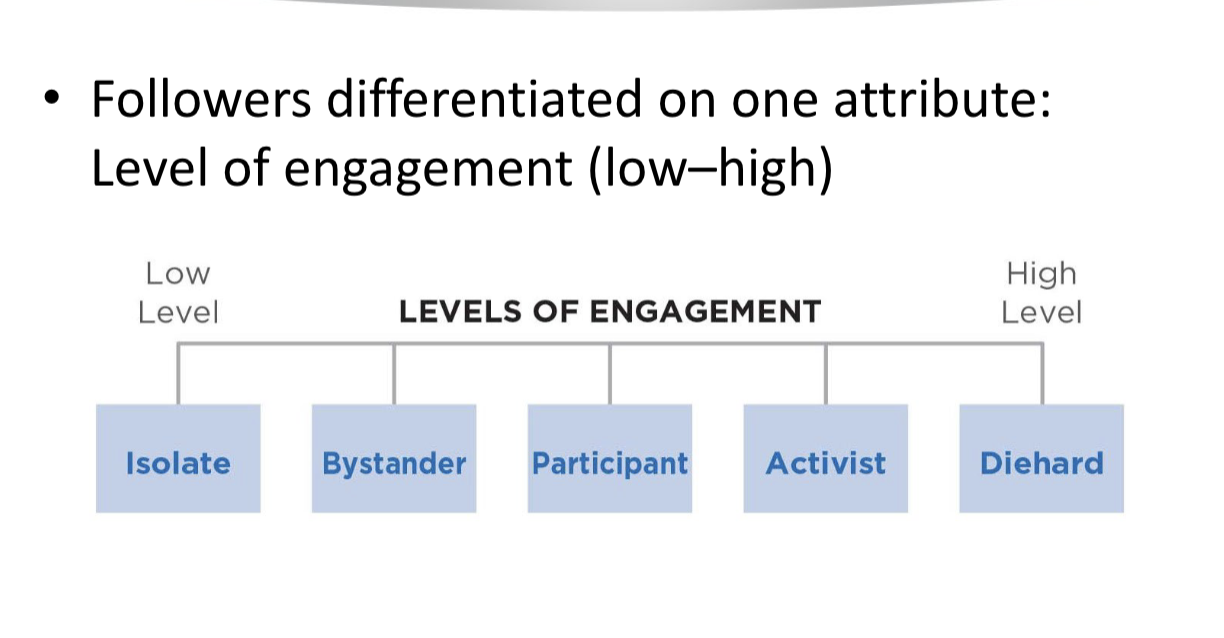
Why Followreship is more important than ever
Leadership Overload: The business world fixates on leadership—books, talks, and consulting—while neglecting the critical role of followership.
Organizational Blind Spot: Despite being key to execution, followership is
vastly under-studied and under-valued in HR and management practice.
Cultural Bias: Society celebrates leaders but rarely praises or even
acknowledges good followers.
AI Resilience: Routine jobs are at risk from AI, but high-level followership
skills—ethical courage, adaptability, and constructive dissent—are among the hardest for AI to replicate.
Call to Action: For long-term success, companies must cultivate not just
visionary leaders but also empowered, engaged followers.
Ethical Pluralism (moral pluraism)
Notion that there are different values that exist
These values may conflict with one another
Different people may prioritize values differently when
they conflictE.g., whether to prioritize individual freedom of
choice versus require individuals to sacrifice
freedom/choice for the good of the community
Two axes used to create ethical lenses in EthicsGames

Biases that may affect leader’s ethical behavior
“Instant entitlement bias”
– Member of team divide the resources equally
– Selected as the “leader” of team keep a much larger share of the resources
for oneself
• Social networks
– People are more likely to inaccurately believe that others agree with them re
what is ethical when they are in the center of a social network (Flynn &
Wiltermuth, 2010)
• CEO’s and leaders = center of social networks
• Leaders may have self-serving rationalizations for unethical behavior that
focus on their own rights at the expense of others’ rights (Keltner, 2017)
How can leaders/ managers encourage their employees to behave ethically?
Leaders must establish their organization’s ethical
normsAsk “What does our organization stand for?”
Set high expectations
Communicate content of norms
Communicate commitment to norms
Employment practices
– Hire ethical people
– Reward ethical behavior
Theranos
medical startup company
exaggerated claims about its blood tests
Key people
– Elizabeth Holmes: Founder & CEO
– Tyler Shultz: employee at Theranos, recent
graduate, whistleblower
o Whistleblower: someone who informs (“blows the
whistle”) on behavior that is unethical and/or illegal
Common Information Effect
Team members spend too much time focusing on shared (“common”) information and neglect unique information
Asymmetrical information
Information is distributed unequally among team members
Asymmetrical interests
Team members have (partially) conflicting goals
Be able to Describe your favourite guest speaker
Kelley
Dean Witt
Sarah Hobgood